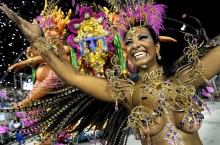Rhythm, paint and glitter
Carnival is the main national holiday in Brazil. It's not just an art and folk festival, but the phenomenon of national scale, an integral part of the Brazilian mentality and priceless cultural heritage of the country. It's like a natural phenomenon as the change of seasons.
The Brazilians have the reasons to consider their carnival as the most spectacular celebration in the world that charges you with endless energy, riot of colors, and roar of samba and dancing crowd. It is an amazing and incomparable experience. On the one hand it can be scary and exciting at the same time when millions of people are applauding you and with you, moving to the rhythm of samba. Those, who were lucky enough to get to the lane and go through the Sambadrome along with dance groups, will never forget that feeling of unity with the elements, when all the body's muscles involuntarily reduced to the beat of samba, and every cell of the body shudders at the drums. At this very moment you can understand the full meaning of this classical expression – a moveable feast .
According to scientists, the word carnival has originated from a combination of two Latin roots: from carno (meat) and vale (goodbye). Up to now there are disputes, which was the source of the carnival tradition. They say it is based on The Funny Day , a holiday, brought to Brazil by the Portuguese, when it was customary to fool each other, pour water over your neighbors, throw raw eggs, corn and beans at peoples. The exultation was accompanied by singing and dancing.
This vivid festival was held before Lent, 40 days before the Holy Week. The first real masquerade was held not so long ago, in 1840. Then the crowd of people was dancing the polka and waltz, moving around the city. Street parades have become part of the holiday for about ten years later. At the same time samba rhythms emerged, these pulsating beats coinciding with the heartbeat. This kind of music is inherent in African nations, and has appeared in Brazil, along with millions of black slave boys and girls. By the way, costumes still include feathers, herbs and bones, which is also reminiscent of the African traditions. Feathers in costume symbolize strength of victory over adversity, passing through which a person becomes stronger and gets divine powers.
According to the National Library, the first surviving record of the samba is the disk of 1917 with a carnival song On The Phone (Pelo Telefone). That is, at this time the samba was written specially for the carnival. It was only the 30th years of the twentieth century, when the first samba school was formed.
Carnival has its own characteristics, flavor, and its own rules in every region of the country. Yet the most famous on the right is a festive parade in Rio de Janeiro. "God created the world in six days, and on the seventh day he created the Rio de Janeiro," say the Brazilians about their favorite city.
A few days before the carnival they choose the next Momo King, who is the fattest man of the contestants, but at the same time he must be cheerful and agile. On the eve of the holiday, the prefect gives him a symbolic key to the city, as if temporarily folding his powers. Since then, the Momo is the only rightful owner of the world capital of samba in the next five days. The main law of these days is simple: have fun!
However, the most interesting event of the carnival is the competitive parade of samba schools at the Marques de Sapukai Sambadrome. It was built in 1984, designed by Oscar Niemeyer, the famous Latin American architect of the last century, one of the founders of the Brazilian architecture modern school. On the eve of his centennial, Niemeyer was awarded with the Order of Friendship - for his great contribution to the development of Russian- Brazilian relations.
At the same time thousands of musicians, dancers and actors play out a scenario conceived. Special costumes and scenery, moving on carts, are created for the festival, and lyrics and music are written. The most luxurious and rich samba school comes to the Sambadrome. Many of them spend millions of Brazilian reais on the sceneries and costumes, which includes feathers, gilding, sequins, and sham jewels. Every school has from 65 to 80 minutes to pass along the Sambadrome on Sapucaí, which length is of 700 meters and width is of 13 meters. The victory is celebrated as a soccer world championship, with fireworks and festivities of the winning school. The participants, who came in second and third place, will also receive cash prizes.
Hundreds of thousands of tourists eager to see the Latin American passion firsthand, all the endless stream of dancers, their unrestrained dancing , and carnival games that are pouring over the edge.






